Organizations & Associations
- Gujarati Society of Central Florida
- Orlando Marathi Mandal
- Bengali Society of Florida
- Telugu Association of Greater Orlando
Recognizing the dual importance of preserving our art and cultural heritage and equipping our younger generation with modern-world proficiencies, the Hindu Society of Central Florida actively organizes a range of programs and tutorials. To explore the current offerings, please click on the respective tabs at the top of the page.
The hindu Society of Central Florida conducts SAT classes with the help of dedicated volunteers of the community. The classes are free except, for a small donation to the institution and a nominal “Guru Dakshina”. Every year many children benefit form the course.
• SAT Math Classes: Every Sunday 7:30AM – 9AM – Mr. Ashok Vyas, Mrs. Pragna Vyas and Sujith Bhatia
• SAT English Class: First Sunday of the Month – Mr. Dillion
• SAT Writting Class: Second Sunday of the Month – Mr. Sandeep Balaji
For More Information, regarding SAT Classes visit: www.satorlando.com
Contact: Vijay Nayyar: Ph: 407-399-4543 Email: nayyarvj@gmail.com
Babu Balasundaram: Ph: 407-334-8006 Email: bbabub@yahoo.com
• Sandwich Club: Second Sunday – Make lunch for homeless shelter (9AM-9:45AM)
Babu Balasundaram: email bbabub@yahoo.com
SAT Mathematics classes Sunday from 7:30 AM to 8:45 AM at Hindu Temple Community Hall (1994 Lake Dr, Casselberry, FL 32707). Please contact Mr. Vijay Nayyar at 407-399-4543 or nayyarvj@gmail.com to learn more and enroll.
SAT English Classes are conducted from 9:00 AM to 4:00 PM once a Month, on a Sunday. Please contact Mr. Vijay Nayyar at 407-399-4543 to enroll and or for more details.
For more information please contact the Temple office.
Please visit: https://www.satorlando.com for more information
Classes to improve English writing skills are conducted once a month on a Sunday from 9:30 AM to 11:30 AM. Please contact Mr. Vijay Nayyar at 407-399-4543
Ms. Geeta Raaj Karkera conducts traditional Bharathanattyam dance classes at the Temple hall. These classes are for children aging from 5 to 18 and for adults as well. Ms. Geeta Karkera is well versed in the Banis, the Tanjavire and the Pandanullur (Kalakshetra). She mastered the dance under the guidance and direction of her Guru, Sri. Mahalingam Pillai of Raja Rajeshwari Bharathanattya Kala Mandir and Guru, Padmashri Adyar Lakshman, Kalakshetra style.
Every Sunday : 10:30 AM to 2:30 PM
Every Wednesday : 5:00 PM to 7:00 PM
Geeta Raaj may be contacted at: 407.265.9959
E-Mail: geetaraaj@hotmail.com
Dr. Meera Ravikumar on Saturdays from 9:00 AM to 10:00 AM. She studied Bharathanatyam for 13 years under the guidance of Dr. Deepak Mazumdar and Smt. Jayashree Nair at the Nalanda University of Dance.
She may be contacted by e-mail: meera93@msn.com
Mrs.Kumuda Sarangaraj conducts music classes for all age groups every Saturday 9 AM to 12 Noon at the temple in the room next to the Board room.
Those interested in Music classes may contact Kumuda Sarangaraj at : 407-456-0877
Smt. Vasundhara Iyengar conducts classes on Carnatic Vocal every Sunday 10:30 AM to 12:00 noon at the Temple hall. Mrs. Vasundhara Iyengar may be contacted at: 407-876-7686; E-Mail: vasuiyengar@aim.com

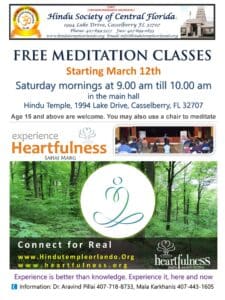

Hinduism is one of the oldest religions of the world. It is undoubtedly the oldest of the living religions. Hidden in its layers are traces of many ancient practices that have been erased completely over time from the memories of the earth. Many scholars north of the equator may not agree with these statements because most of them read or believe that the history of the world began in Greece, meandered through medieval Europe and then moved on through the imperialism of Europe and the industrialization of the new world. For them the world beyond the Mediterranean in ancient times was mostly Ireland and Scotland, the Aryans probably came to the subcontinent not on the strength of their sword but as settlers with their families, rich traditions and wealth of horses and cattle. To the new inhabitants of the land of the five rivers, the Vedic hymns were products of a very ancient wisdom, received by them through oral tradition and through generations of scholars and seers starting from the time of Manu, the first man on earth.
If we accept this as a religious truth, for there seems to be no reason why we should not, then the Vedic religion, which is a precursor of the present day Hinduism, should have its antecedents rooted in the prehistoric times, when the aboriginal men were slowly stretching their minds to understand the mysteries of their own existence and the mysteries of the world around them!
Hinduism differs from other organized religions in the following aspects:
Universal acceptance and tolerance are two basic pillars of Hinduism!
Hinduism is not a religion in the strictest sense of the word, but an ancient tradition in continuity and in perpetual evolution is an unquestionable fact. To try to define Hinduism is like trying to put the waters of an unfathomable ocean into a small vessel, or to capture the essence of human life in a single word or phrase.
With a structured definition we may be able to capture the essential elements of Hinduism and satisfy our intellectual curiosity. But it is highly doubtful if that would justify the significance of a tradition that began in prehistoric times and eventually grew into a complex system of religious thought and beliefs, which we recognize today under the generic name of ”Hinduism”. And which has been still growing!
Hinduism can be truly called an Asvaththa tree whose roots are above and whose branches are spread throughout below. The roots are the traditions that we inherited from the Rigvedic Aryans or their ancestors. The branches are the various new schools of thought and practices that were incorporated into it during the subsequent periods in history. The trunk is belief in the eternal nature of soul and of supreme God who are central to Hinduism.
Hinduism, we are told, is not a religion at all, but a way of life. In a way this is quite true. According to the tenets of Hinduism, life and religion are inseparable. Religion is there every where, like the omnipresent Brahman, dominating and regulating every aspect of human life, infusing it with divine presence and making life more meaningful and purposeful to its followers.
It virtually controls every action of a devout Hindu. Though he has immense freedom to follow a path of his own choice, the invisible hands of religion moulds his thinking at every step, making him almost slavish in his mentality towards his or her gods. Beneath his mind, religion remains, like a substratum or the bed of a flowing river, influencing all his decisions and actions.
To understand the true nature and significance of Hinduism it is essential to examine the roots of the so called modern Hinduism and at the historical process from which it has emerged in its present shape
Throughout its entire history, Hinduism was never static. It evolved continuously from stage to stage and went on transforming itself continuously. This was due to the self less and extraordinary contribution by many scholars, seers, sages, institutions, kings and emperors, over a vast period of time.
By correcting, moulding, modifying, and integrating various aspects of the religion to suit the social, political, material, intellectual and spiritual requirements of the times, these great souls kept the religious lamp shining and vibrating. They provided knowledge and guidance to the multitude of beings, while barbarism and savagery still ruled many parts of the world.
It was they who gave the religion the depth and complexity for which it is known today, making it, as far as possible, acceptable to a great majority of the Indian people. Because of them Hinduism became more or less like an ocean that would absorb every thing that flowed into it from all directions.
Like an ocean it remained stable and firmly entrenched in its place and went on absorbing new knowledge and religious insights from all directions, without losing in the process, its moorings and its original character. It did not compromise on its basic ideals, nor suffered unduly from the process of assimilation and adaptation. Instead, it grew in strength and capacity, to illuminate and enlighten the ignorant minds, absorbing new thoughts and concepts, without discarding the old, without rejecting what it has already gathered. It integrated both the old and the new in a very peaceful and harmonious way.
This flexible approach helped it to survive against the onslaught of new religious movements and invasion of foreign ideas. But in the process it also amassed a great body of inner contradictions, which today stand out prominently, making it incomprehensible to many outsiders.
The Buddha was not the first social or religious reformer of ancient India. Prior to him there were many and Lord Krishna himself was one of the most prominent. To a careful reader of the Bhagavad-Gita it becomes self-evident that the scripture was a reaction against religious conditions of those times.
It was definitely a new line of thought that tried to discard meaningless and superficial ideas and integrate divergent and relevant ideas into one meaningful whole. It tried to resolve the contradictions inherent in following the path of devotion, the path of knowledge, the path of renunciation by a Vedic householder leading an active and normal life.
The six darsanas or the six schools of Hindu thought, the emergence of Charvakas or Lokayatas, Parivrajakas, Ajivakas and Nirgaranthas, apart from the raise of Buddhism and Jainism, were also products of similar reaction only. They were, some times vehemently, almost fanatically, against the attempts of the Vedic priests to monopolize religious authority through the clever manipulation of their scriptural knowledge and social advantage.
The Upanishads, the end part of the Vedas, were also products of scholarly reaction against the tyranny of the vedic ritualism sanctioned by the Samhitas and Brahmanas.
Similar was the case with the Bhakti movement, which originally started in the south in the first or the second century A.D., and culminated in the subsequent rise and popularity of Saivism and Vaishnavism.
The rise of the Tantrism and other movements, at a time when Buddhism and Jainism were on the ascendance and gaining ground, added complexity and depth to the ancient Indian religious thought and provided it the much needed diversity for which it is famous today.
The schools of Monism (Advaita), Dualism (Dualism) and Qualified Dualism (Vishishtadvaita) were the internal reactions, which attracted the attention of many seekers of truth and encouraged them to explore the true nature of the reality of the world in which they lived.
It is said that competition amongst these divergent sampradayas (traditions) was very intense, some times resulting in religious intolerance, infrequent wars and quarrels, religious debate and mutual abuse.
But some how, out of this tumultuous situation, the Vedic religion emerged, a little bit battered and bruised, but surviving in spirit and dignity, gaining depth and complexity. It was still able to wield influence over large sections of society, and attracted new adherents into its fold, despite of the debacle of the varna system and the attitude of the upper castes.
To learn more about Hinduism, please visit:https://www.hinduwebsite.com and https://www.hinduismtoday.com
MOTTO OF NEW AGE GROUP
We are bastion of HAPPY AND HEALTHY HEARTS for everyone who
comes to us from whichever corner of the world:
NORTH, SOUTH, EAST OR WEST
WE ENDEAVOR TO NOURISH ACTIVE MINDS, HEALTHY BODIES AND HAPPY HEARTS
We achieve this by conducting educational seminars; playing joyful games and having fun-filled excursions.
We also believe in the following dictum:
(1) WHERE WE ARE?
We have not left any stone unturned to enroll members to the Group. We have e-mailing list of over 1500 addresses of which more than 200 members have signed up for annual membership.
The Planning Group comprises of 14 persons of which four couples are most regular. Recently we recruited fresh members to Planning Group in lieu of the non-regular ones– we believe the new members would take more active part on a regular basis. Generally, the group meets once a month to plan for the monthly events. .Several Seminars on various health topics; yoga; wealth management; Tax laws, Social security; Wills; Trusts; Probate; Elders safety etc., have been conducted. Picnics, Cruises were also arranged.
Where we want to reach?
A. SHORT-TERM GOAL for 2016: Essay Competition for children at Grand Parents Day celebrations
B. LONG TERM GOAL: b.1: Well beginnings of all BIG things are small!!! Our aspiration is to become a HUB for the baby-boomers of Indian Origin and HSCF to become at par with centers for Indians established at Canada, England, Los Angeles, and Chicago. As more and more retirees from North continue to move to this wonderful WARM land, we would like to be geared to WELCOME and provide them with a common meeting place. If we continue to receive the usual support from all of you, HSCF management as well as honored contributors, our dreams would soon be fulfilled.
b.2 : To have an independent Activity Room where the Seniors could have games like table tennis, carom, chess, playing cards, newspapers, etc. etc. on a regular basis – this should be a hub of activities like any senior centers run by the State in various localities. This would benefit not only the seniors but also the juniors who could mingle with the seniors and learn from their experiences.
b.3: To have our own self-contained Living Quarters Complex.
NB: THIS IS A SELF-SUPPORTING GROUP – YOU ARE WELCOME TO CONTRIBUTE GENEROUSLY TO ENHANCE IT FURTHER – ALL CONTRIBUTIONS ARE TAX FREE – WRITE CHECKS TO “HSCF” IN MEMO KINDLY WRITE : “NEW AGE GROUP” and mail it to :
HSCF NEW AGE (SENIORS) GROUP
c/o Madan Arora,
569 Horseman Drive,
Oviedo,FL-32765
For more information, please contact by e-mail or call:
Madan Arora: 407.971.9259
Dev Sharma: 407.862.9920
Sadananda Pande: 407.542.7478
E-Mail hscfnewagegroup@gmail.com
The hindu Society of Central Florida conducts SAT classes with the help of dedicated volunteers of the community. The classes are free except, for a small donation to the institution and a nominal “Guru Dakshina”. Every year many children benefit form the course.
• SAT Math Classes: Every Sunday 7:30AM – 9AM – Mr. Ashok Vyas, Mrs. Pragna Vyas and Sujith Bhatia
• SAT English Class: First Sunday of the Month – Mr. Dillion
• SAT Writting Class: Second Sunday of the Month – Mr. Sandeep Balaji
For More Information, regarding SAT Classes visit: www.satorlando.com
Contact: Vijay Nayyar: Ph: 407-399-4543 Email: nayyarvj@gmail.com
Babu Balasundaram: Ph: 407-334-8006 Email: bbabub@yahoo.com
• Sandwich Club: Second Sunday – Make lunch for homeless shelter (9AM-9:45AM)
Babu Balasundaram: email bbabub@yahoo.com
SAT Mathematics classes Sunday from 7:30 AM to 8:45 AM at Hindu Temple Community Hall (1994 Lake Dr, Casselberry, FL 32707). Please contact Mr. Vijay Nayyar at 407-399-4543 or nayyarvj@gmail.com to learn more and enroll.
SAT English Classes are conducted from 9:00 AM to 4:00 PM once a Month, on a Sunday. Please contact Mr. Vijay Nayyar at 407-399-4543 to enroll and or for more details.
For more information please contact the Temple office.
Please visit: https://www.satorlando.com for more information
Classes to improve English writing skills are conducted once a month on a Sunday from 9:30 AM to 11:30 AM. Please contact Mr. Vijay Nayyar at 407-399-4543
Ms. Geeta Raaj Karkera conducts traditional Bharathanattyam dance classes at the Temple hall. These classes are for children aging from 5 to 18 and for adults as well. Ms. Geeta Karkera is well versed in the Banis, the Tanjavire and the Pandanullur (Kalakshetra). She mastered the dance under the guidance and direction of her Guru, Sri. Mahalingam Pillai of Raja Rajeshwari Bharathanattya Kala Mandir and Guru, Padmashri Adyar Lakshman, Kalakshetra style.
Every Sunday : 10:30 AM to 2:30 PM
Every Wednesday : 5:00 PM to 7:00 PM
Geeta Raaj may be contacted at: 407.265.9959
E-Mail: geetaraaj@hotmail.com
Dr. Meera Ravikumar on Saturdays from 9:00 AM to 10:00 AM. She studied Bharathanatyam for 13 years under the guidance of Dr. Deepak Mazumdar and Smt. Jayashree Nair at the Nalanda University of Dance.
She may be contacted by e-mail: meera93@msn.com
Mrs.Kumuda Sarangaraj conducts music classes for all age groups every Saturday 9 AM to 12 Noon at the temple in the room next to the Board room.
Those interested in Music classes may contact Kumuda Sarangaraj at : 407-456-0877
Smt. Vasundhara Iyengar conducts classes on Carnatic Vocal every Sunday 10:30 AM to 12:00 noon at the Temple hall. Mrs. Vasundhara Iyengar may be contacted at: 407-876-7686; E-Mail: vasuiyengar@aim.com



Hinduism is one of the oldest religions of the world. It is undoubtedly the oldest of the living religions. Hidden in its layers are traces of many ancient practices that have been erased completely over time from the memories of the earth. Many scholars north of the equator may not agree with these statements because most of them read or believe that the history of the world began in Greece, meandered through medieval Europe and then moved on through the imperialism of Europe and the industrialization of the new world. For them the world beyond the Mediterranean in ancient times was mostly Ireland and Scotland, the Aryans probably came to the subcontinent not on the strength of their sword but as settlers with their families, rich traditions and wealth of horses and cattle. To the new inhabitants of the land of the five rivers, the Vedic hymns were products of a very ancient wisdom, received by them through oral tradition and through generations of scholars and seers starting from the time of Manu, the first man on earth.
If we accept this as a religious truth, for there seems to be no reason why we should not, then the Vedic religion, which is a precursor of the present day Hinduism, should have its antecedents rooted in the prehistoric times, when the aboriginal men were slowly stretching their minds to understand the mysteries of their own existence and the mysteries of the world around them!
Hinduism differs from other organized religions in the following aspects:
Universal acceptance and tolerance are two basic pillars of Hinduism!
Hinduism is not a religion in the strictest sense of the word, but an ancient tradition in continuity and in perpetual evolution is an unquestionable fact. To try to define Hinduism is like trying to put the waters of an unfathomable ocean into a small vessel, or to capture the essence of human life in a single word or phrase.
With a structured definition we may be able to capture the essential elements of Hinduism and satisfy our intellectual curiosity. But it is highly doubtful if that would justify the significance of a tradition that began in prehistoric times and eventually grew into a complex system of religious thought and beliefs, which we recognize today under the generic name of ”Hinduism”. And which has been still growing!
Hinduism can be truly called an Asvaththa tree whose roots are above and whose branches are spread throughout below. The roots are the traditions that we inherited from the Rigvedic Aryans or their ancestors. The branches are the various new schools of thought and practices that were incorporated into it during the subsequent periods in history. The trunk is belief in the eternal nature of soul and of supreme God who are central to Hinduism.
Hinduism, we are told, is not a religion at all, but a way of life. In a way this is quite true. According to the tenets of Hinduism, life and religion are inseparable. Religion is there every where, like the omnipresent Brahman, dominating and regulating every aspect of human life, infusing it with divine presence and making life more meaningful and purposeful to its followers.
It virtually controls every action of a devout Hindu. Though he has immense freedom to follow a path of his own choice, the invisible hands of religion moulds his thinking at every step, making him almost slavish in his mentality towards his or her gods. Beneath his mind, religion remains, like a substratum or the bed of a flowing river, influencing all his decisions and actions.
To understand the true nature and significance of Hinduism it is essential to examine the roots of the so called modern Hinduism and at the historical process from which it has emerged in its present shape
Throughout its entire history, Hinduism was never static. It evolved continuously from stage to stage and went on transforming itself continuously. This was due to the self less and extraordinary contribution by many scholars, seers, sages, institutions, kings and emperors, over a vast period of time.
By correcting, moulding, modifying, and integrating various aspects of the religion to suit the social, political, material, intellectual and spiritual requirements of the times, these great souls kept the religious lamp shining and vibrating. They provided knowledge and guidance to the multitude of beings, while barbarism and savagery still ruled many parts of the world.
It was they who gave the religion the depth and complexity for which it is known today, making it, as far as possible, acceptable to a great majority of the Indian people. Because of them Hinduism became more or less like an ocean that would absorb every thing that flowed into it from all directions.
Like an ocean it remained stable and firmly entrenched in its place and went on absorbing new knowledge and religious insights from all directions, without losing in the process, its moorings and its original character. It did not compromise on its basic ideals, nor suffered unduly from the process of assimilation and adaptation. Instead, it grew in strength and capacity, to illuminate and enlighten the ignorant minds, absorbing new thoughts and concepts, without discarding the old, without rejecting what it has already gathered. It integrated both the old and the new in a very peaceful and harmonious way.
This flexible approach helped it to survive against the onslaught of new religious movements and invasion of foreign ideas. But in the process it also amassed a great body of inner contradictions, which today stand out prominently, making it incomprehensible to many outsiders.
The Buddha was not the first social or religious reformer of ancient India. Prior to him there were many and Lord Krishna himself was one of the most prominent. To a careful reader of the Bhagavad-Gita it becomes self-evident that the scripture was a reaction against religious conditions of those times.
It was definitely a new line of thought that tried to discard meaningless and superficial ideas and integrate divergent and relevant ideas into one meaningful whole. It tried to resolve the contradictions inherent in following the path of devotion, the path of knowledge, the path of renunciation by a Vedic householder leading an active and normal life.
The six darsanas or the six schools of Hindu thought, the emergence of Charvakas or Lokayatas, Parivrajakas, Ajivakas and Nirgaranthas, apart from the raise of Buddhism and Jainism, were also products of similar reaction only. They were, some times vehemently, almost fanatically, against the attempts of the Vedic priests to monopolize religious authority through the clever manipulation of their scriptural knowledge and social advantage.
The Upanishads, the end part of the Vedas, were also products of scholarly reaction against the tyranny of the vedic ritualism sanctioned by the Samhitas and Brahmanas.
Similar was the case with the Bhakti movement, which originally started in the south in the first or the second century A.D., and culminated in the subsequent rise and popularity of Saivism and Vaishnavism.
The rise of the Tantrism and other movements, at a time when Buddhism and Jainism were on the ascendance and gaining ground, added complexity and depth to the ancient Indian religious thought and provided it the much needed diversity for which it is famous today.
The schools of Monism (Advaita), Dualism (Dualism) and Qualified Dualism (Vishishtadvaita) were the internal reactions, which attracted the attention of many seekers of truth and encouraged them to explore the true nature of the reality of the world in which they lived.
It is said that competition amongst these divergent sampradayas (traditions) was very intense, some times resulting in religious intolerance, infrequent wars and quarrels, religious debate and mutual abuse.
But some how, out of this tumultuous situation, the Vedic religion emerged, a little bit battered and bruised, but surviving in spirit and dignity, gaining depth and complexity. It was still able to wield influence over large sections of society, and attracted new adherents into its fold, despite of the debacle of the varna system and the attitude of the upper castes.
To learn more about Hinduism, please visit:https://www.hinduwebsite.com and https://www.hinduismtoday.com
MOTTO OF NEW AGE GROUP
We are bastion of HAPPY AND HEALTHY HEARTS for everyone who
comes to us from whichever corner of the world:
NORTH, SOUTH, EAST OR WEST
WE ENDEAVOR TO NOURISH ACTIVE MINDS, HEALTHY BODIES AND HAPPY HEARTS
We achieve this by conducting educational seminars; playing joyful games and having fun-filled excursions.
We also believe in the following dictum:
(1) WHERE WE ARE?
We have not left any stone unturned to enroll members to the Group. We have e-mailing list of over 1500 addresses of which more than 200 members have signed up for annual membership.
The Planning Group comprises of 14 persons of which four couples are most regular. Recently we recruited fresh members to Planning Group in lieu of the non-regular ones– we believe the new members would take more active part on a regular basis. Generally, the group meets once a month to plan for the monthly events. .Several Seminars on various health topics; yoga; wealth management; Tax laws, Social security; Wills; Trusts; Probate; Elders safety etc., have been conducted. Picnics, Cruises were also arranged.
Where we want to reach?
A. SHORT-TERM GOAL for 2016: Essay Competition for children at Grand Parents Day celebrations
B. LONG TERM GOAL: b.1: Well beginnings of all BIG things are small!!! Our aspiration is to become a HUB for the baby-boomers of Indian Origin and HSCF to become at par with centers for Indians established at Canada, England, Los Angeles, and Chicago. As more and more retirees from North continue to move to this wonderful WARM land, we would like to be geared to WELCOME and provide them with a common meeting place. If we continue to receive the usual support from all of you, HSCF management as well as honored contributors, our dreams would soon be fulfilled.
b.2 : To have an independent Activity Room where the Seniors could have games like table tennis, carom, chess, playing cards, newspapers, etc. etc. on a regular basis – this should be a hub of activities like any senior centers run by the State in various localities. This would benefit not only the seniors but also the juniors who could mingle with the seniors and learn from their experiences.
b.3: To have our own self-contained Living Quarters Complex.
NB: THIS IS A SELF-SUPPORTING GROUP – YOU ARE WELCOME TO CONTRIBUTE GENEROUSLY TO ENHANCE IT FURTHER – ALL CONTRIBUTIONS ARE TAX FREE – WRITE CHECKS TO “HSCF” IN MEMO KINDLY WRITE : “NEW AGE GROUP” and mail it to :
HSCF NEW AGE (SENIORS) GROUP
c/o Madan Arora,
569 Horseman Drive,
Oviedo,FL-32765
For more information, please contact by e-mail or call:
Madan Arora: 407.971.9259
Dev Sharma: 407.862.9920
Sadananda Pande: 407.542.7478
E-Mail hscfnewagegroup@gmail.com
The Hindu Society Central Florida Youth Group meets every Sunday at the temple.
Its mission statement is:
To provide a forum for the youth to learn and apply the principles of their Hindu heritage through various activities and opportunities for self development & community service. It will strive to develop leadership, spiritual, emotional and cultural identity of the HSCF youth.
For more information or to join the group, please contact HSCF Front Office at 407-699-5277 or Babu Balsundaram at 407-334-8006, email: bbabub@yahoo.com
The Hindu Society Central Florida Youth Group meets every Sunday at the temple.
Its mission statement is:
To provide a forum for the youth to learn and apply the principles of their Hindu heritage through various activities and opportunities for self development & community service. It will strive to develop leadership, spiritual, emotional and cultural identity of the HSCF youth.
For more information or to join the group, please contact HSCF Front Office at 407-699-5277 or Babu Balsundaram at 407-334-8006, email: bbabub@yahoo.com
Join a Vibrant Community Celebrating Hindu Culture and Traditions


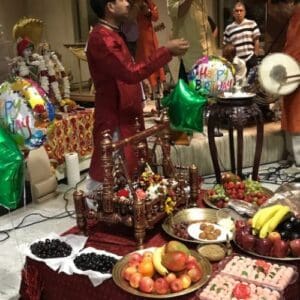





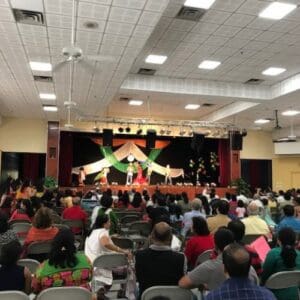




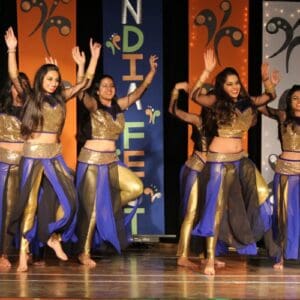

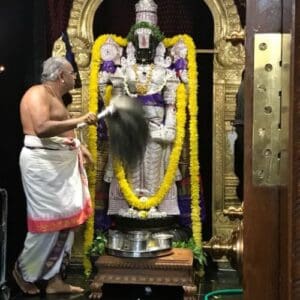
©2023 Designed by Cobia Marketing All Rights Reserved.